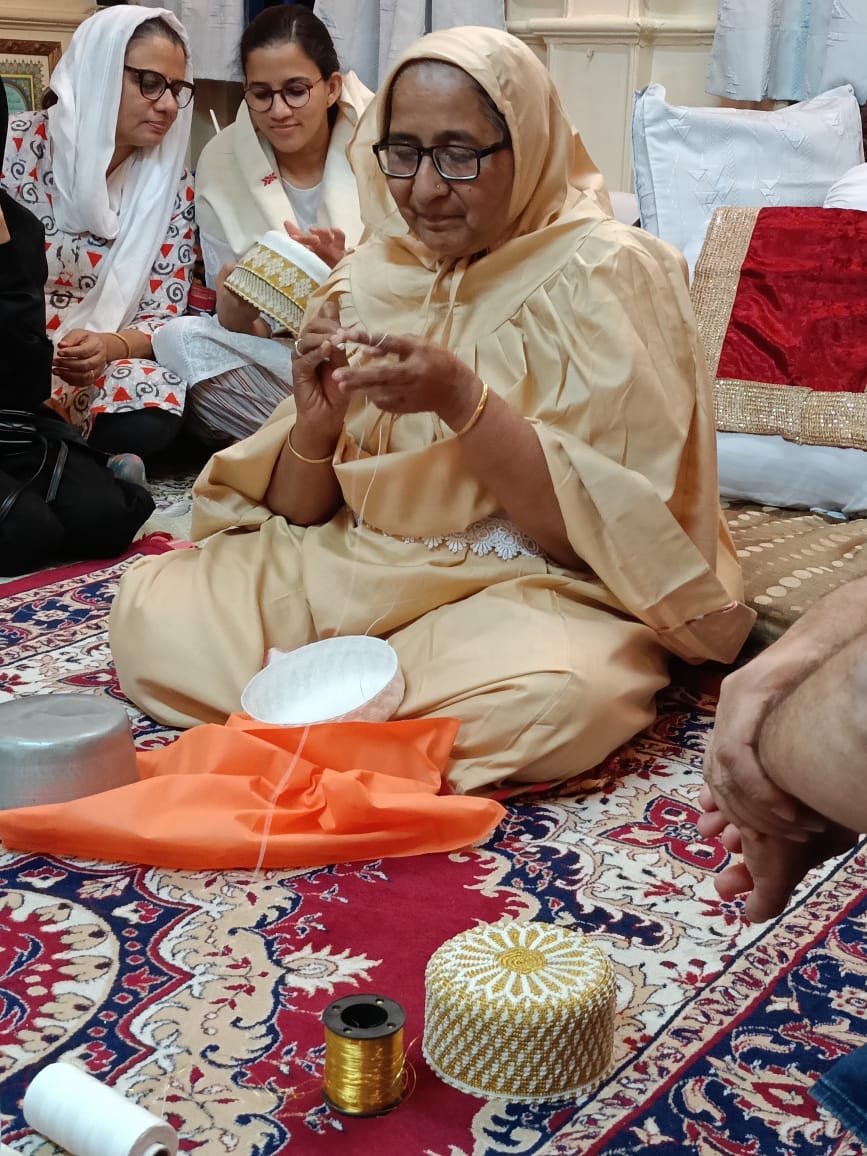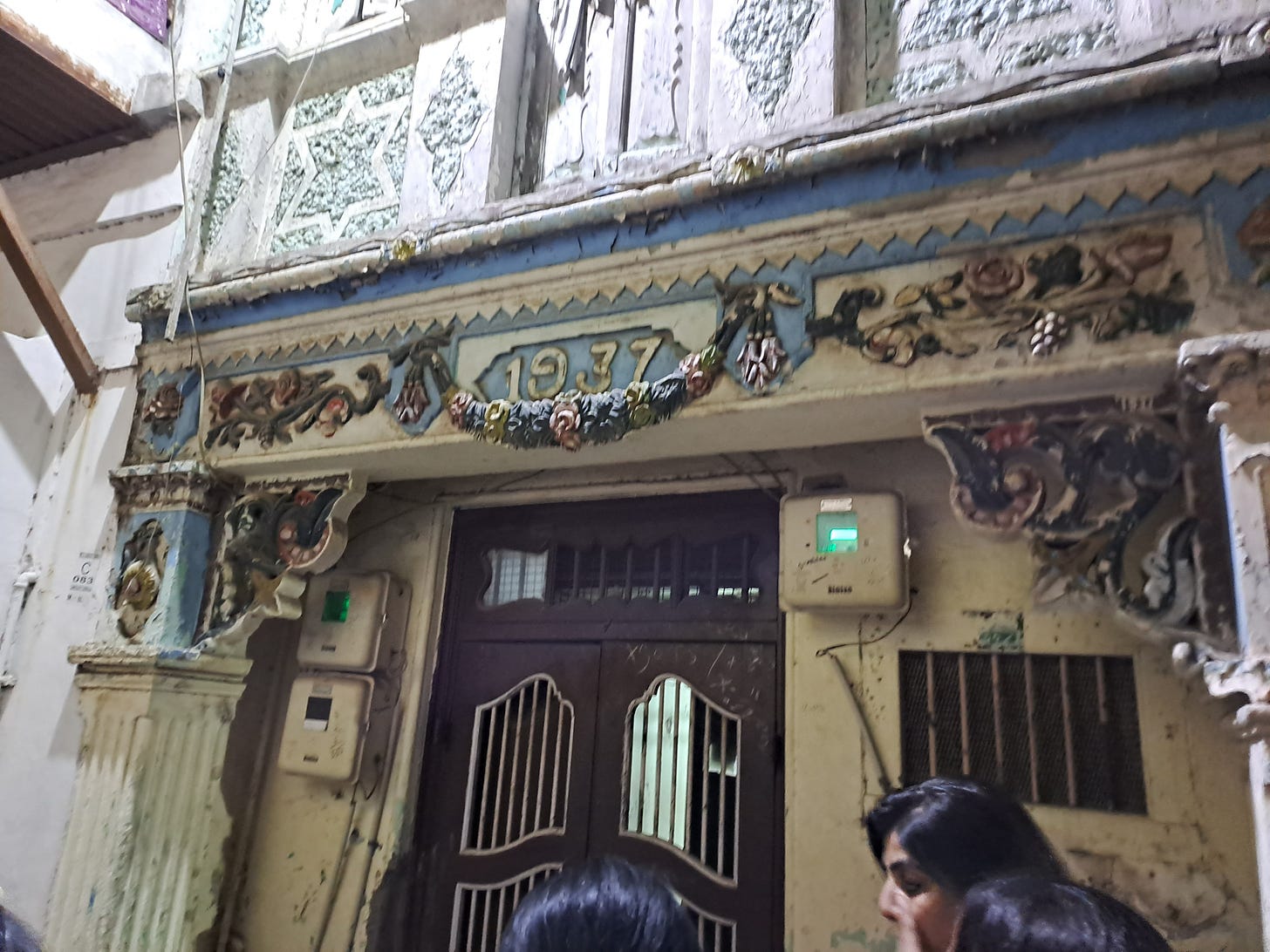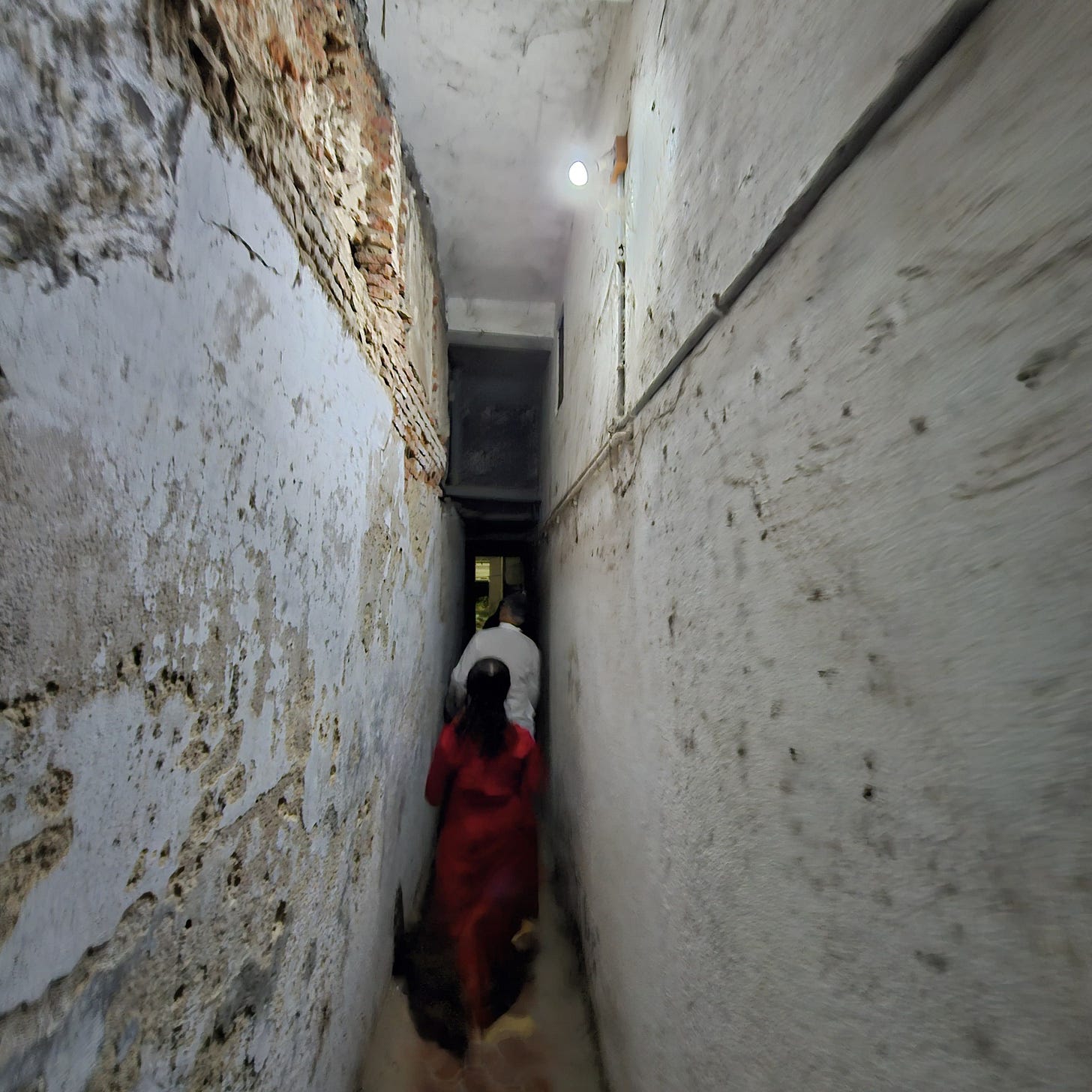The current global population of the Alavi Bohras is barely 8000. Of these, 6500 live in my small town. Surprised? Even I was.
I was first introduced to the low-profile Alawi Bohra community by Chandrashekhar Patil in November 2015 at the very first week-long Vadodara Peoples Heritage Festival. Patil had managed to convince the leaders of this very tiny community to participate in the Festival with an ‘Alavi Bohra Walk’ and for the very first time the Badri Mohalla in the Wadi-Gendigate where most of the families live and which houses the home and office of the 45th Saiyedna Saheb, their spiritual leader, saw so many Barodians interact with the community, welcomed warmly into their Art Deco-style homes with beautiful wooden furniture, especially cupboards.
The Walk participants get an audience with His Holiness, the Saiyedna Saheb. Pic by Mini Kumar, one of the Walkers.
That event, which incidentally inaugurated the Festival that year, has since worked very well for both – the Alavi community and Heritage Trust. The Alavi Bohras suddenly got a lot of media coverage. The Saiyedna Saheb’s younger brother, Bhaisaheb Zulqarnain, who is a practicing homeopath, has been involved in encouraging boys and young adults to take up several adventure and sporting activities such as cycling, trekking, limited over cricket tournaments and so on. Many of these are now covered regularly by the local media. On the other hand, the Trust has organised Heritage Walks here ending with their superb traditional ‘thaal’ meal! The most recent Walk was held on last Sunday. But more of that later …
One of the buildings in Badri Mohalla. Pic by Ashish Luhana, one of the Walkers.
The Alavi Bohra community’s engagement with my town (which has been their home for about 350 years now) has been constant but muted. The community is essentially mercantile, trading in glass, metals, textiles, civil engineering hardware, sanitaryware, paints, and so on. Education is highly valued (there is 100% literacy), and most girls complete graduation, if not high school. However, their presence has been so low profile, that the unique language they speak – Lesaan ud Da’wat – a blend of four languages – Arabic, Persian, Urdu and Gujarati (with a predominance of Gujarati) and written in the Arabic script, completely escaped the researchers at Bhasha and it was a matter of pure bad luck that it missed being included as one of the active spoken languages in the Gujarat state volume of the encyclopedic Peoples Linguistic Survey of India prepared by Bhasha Research and Publication Centre in 2013-14.
The Alavi Bohras trace their ancestry to more than 1000 years back when a group of selected scholars were sent from Yemen by the Imam to establish the Isma’ili-Taiyebi Da’wat in Khambhat/Cambay, Gujarat. (Khambhat was then a very important port from which global trade happened, especially to the east and north-east African countries.) The new community established here came to be known as the Bohras, the name signifying those who did ‘vyavahar’, a Gujarati word, or who were ‘traders’. Between 1422 and 1640, there were two major splits that occurred in the mainstream Bohra community, leading to the formation of three major groups of Bohras – Alavis, Dawoodis and Sulaymanis. (Incidentally, like the Alavis, the Sulaymanis are also about 8000 + in India and a quarter of them live in Baroda. The Dawoodi Bohras are the largest amongst the three with more than 10 lakh persons in the community in India.)
Mallikaben, one of the few craftswomen left in the community here to handmake the headgear, a must-wear for the males in the community. Pic by Prof. Pratyush Shankar, one of the Walkers.
When planning a heritage walk in any area of our town, I always do a recce no matter how familiar I am with all the points of contacts. In a living town, things can change dramatically in a manner of months. The first Bohra Walk in 2015 was an eye-opener, because obviously I was experiencing everything for the first time. When I put together a Walk for the Heritage Trust in 2020 just weeks before the planet went crazy with Covid, I penciled in the ‘thaal’ dinner for the Walk participants to experience a different dining tradition. During that evening Walk, Bhaisaheb Zulqarnain guided us through several iconic Art Deco buildings in the Mohalla, some of them empty of their original owners (who were living elsewhere in the country or abroad) but where local caretakers had the keys. Though the Mohalla is not very long, and even taking into consideration that the Walk included a meeting with the Saiyedna, the Walk group managed to reach the dinner site only around 8.30 pm at the modern Talib Patel designed Noorani Masjid’s jamaatkhana just at the mouth of the Mohalla. That’s how much there was to see in there, how very much to photograph!
It took me a long time to plan the next Walk, post- Covid. Personally, I felt that the thaal meal is one of the highlights of this Walk but I found that the meal prices were a major deterrent to persons registering enough in advance. And that was a chicken-and-egg situation. If enough people did not register, I could not finalise the Walk well enough in advance to give the community cooks time to plan and prepare the meal. That led to a couple of last minute cancelled Walks. Finally, things somewhat came together and we did a Walk last Sunday.
Facade of a home in Fakhri Mohalla.
But it was a completely different Walk than the last one. Time had taken its toll, as it always does. Many old buildings were replaced by narrow 6-7 storey high modern structures. The old house that was opened for us by the caretaker last time was locked and mired in dust as the caretaker herself had passed away, her own home bolted and padlocked. So Bhaisaheb took us on another walk down history.
The old facade of the Taaj Masjid in Fakhri Mohalla. Pic. shared by Bhaisaheb Zulqarnain.
It was during the 1612-1638 AD period that the Alavis migrated to Baroda from Ahmedabad and Khambat. The 28th, 29th and 30th Da’i al-Mutlaq were all born in Baroda, in the Fakhri Mohalla near Gendigate. This Mohalla also houses several Alavi Bohra families. During the time when the Gujarat Sultanate ruler Muzaffar Shah III (around 1570s) ruled Gujarat, Saiyedi Musanji bin Taaj Saheb of Vadodara went on pilgrimage to Haj and promised to build a mosque if he would return to Baroda safe and sound. Which he fortunately did. So he built the mosque in Fakhri Mohalla, the oldest mosque for Alavi Bohras in Baroda. But in the meanwhile, the Moghuls had already conquered Gujarat calling an end to the Gujarat Sultanate. There was some disagreement regarding the inauguration of the new mosque between Taaj Saheb and the local Moghul emissary and it led to a horrifying torture and martyrdom of Taaj sahib at Mandvi. His grave/mazaar is outside of Panigate.
The Patli Gali in Fakhri Mohalla! Pic by Ashish Luhana.
So we walked to the Fakhri Mohalla, even smaller than the Badri Mohalla, taking in the crowded markets on both sides of the street, shops selling indigenous perfumes, woven headgear with intricate geometrical designs worn by the males in the community, textiles, footwear, spices, and what have you. The Fakhri Mohalla is opposite a vast old Wada that stretches a good 150 meters along the street (another reason to go to that part of the Walled City!). Two buildings with intricate decorative stucco work on the façade rise almost five storeys high, both locked. They were built a few years before Independence when the Art Deco movement in India was at the height of its popularity. At the end of that short lane is the entrance to the Fakhri Masjid also called Taaj Masjid, but recently re-named again after the extensive repairs and reconstruction work to the old structure. But the even more interesting aspect is the patli gali right next to the masjid that allows just one person at a time to walk along and which turns right as we go along, the wall to the left made by the really old narrow bricks that date pre-British. At both ends of the patli gali were metal poles stuck right in the middle. For a minute I wondered why. Then I realized – it was to make sure that no over- confident idiot tried to ride a cycle or a two wheeler and got stuck in the middle. In fact, at the entrance to the gali on the masjid side even had a triangular piece removed from the stone step of the home right next to it, so as to make it easy for a person to step into the gali. The old buildings on the other side of the gali were in a poor shape but one could still see how once they must have been the glory of these congested mohalla-s.
The non-veg Thaal! First course!
And from here we went back to the masjid to the hall on the first floor to a delightful and tastefully presented thaal meal, six of us around a large platter on which were placed plates of salad, fragrant mava-filled ghughra, a undhiyu with fried and spiced mutton pieces, a fabulous steamed fish with flavor-some green chutney, chicken biryani with raita, followed by fresh fruit and phirni in clay bowls and finally, paan. I didn’t know what the veggie thaal held but the diners were most satiated so I guess that was equally mouth-watering. Couldn’t be a better end to a wonderful Sunday!











Well done Sandhya. I was on that first walk: my daughter Samira had conducted some research on the history of the Alawis and struck a bond with the Bhaisaheb. He remembered that.
Fascinating story of the minuscule minority.